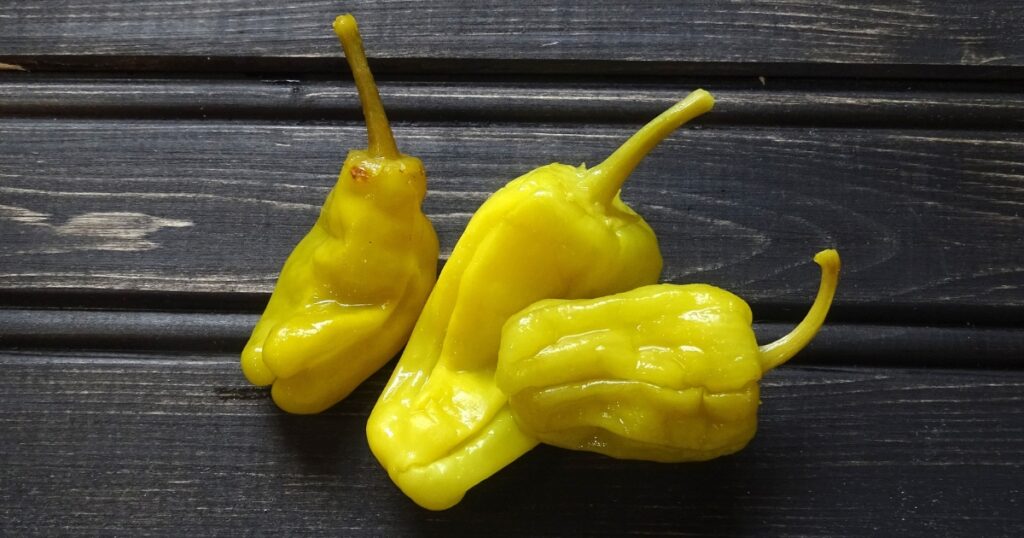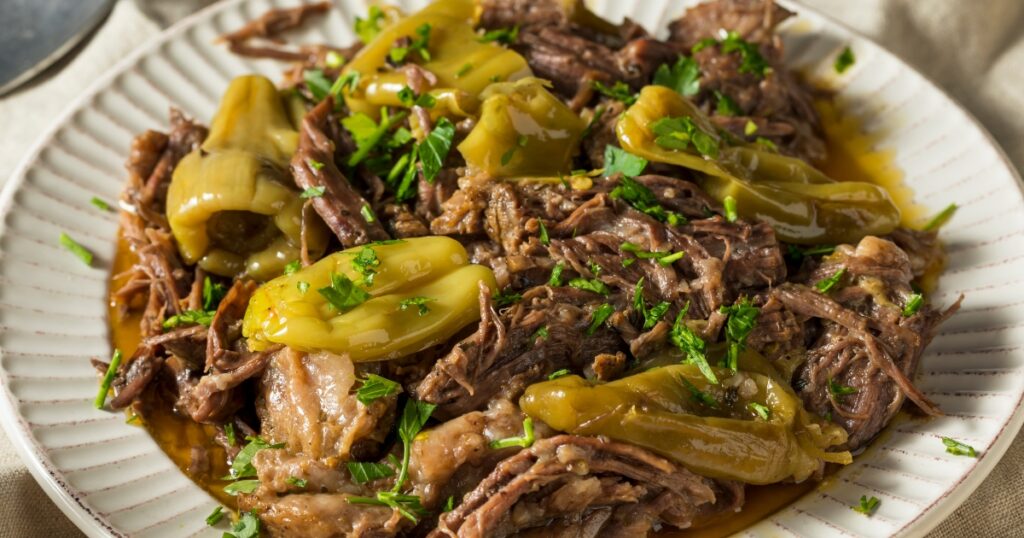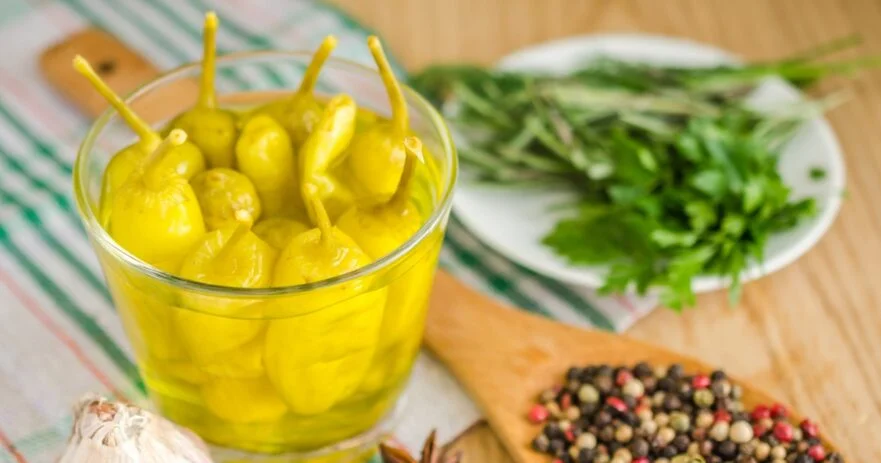In this article about pepperoncini:
🗺️ Origin and history | 🌶️ Uses | ✨ Appearance and taste | 🧑🌾 Growing – gardening | 👨🍳 Cooking – recipes | 🛒 Where to buy | 🫙 How to store | 👨⚕️ Health benefits | 🌶️ Alternatives and substitutes | ❓ Frequently asked questions
What is pepperoncini?
Pepperoncini peppers are a type of mild chili pepper native to Italy and Greece. They‘re small and tapered, ranging in color from light green to bright red or yellow when fully ripe. Pepperoncinis are often sold pickled in jars and can be found pretty easily in grocery stores. These peppers are also known as Tuscan Peppers, sweet Italian peppers, or golden Greek peppers.
Pepperoncinis are slightly sweet and tangy in flavor and have a pretty low heat level, ranging from 100 to 500 Scoville heat units, which is barely above a bell pepper on the Scoville scale! These peppers are versatile ingredients that add a unique crunch and tangy flavor to various dishes. They‘re commonly served in Italian antipasti, salads, pizzas, and sub sandwiches.
| Pepperoncini pepper | |
| SHU | 100 - 500 |
| Median SHU | 300 |
| Flavor | Mildly sweet and tangy, with a slight heat |
| Species | Capsicum annuum |
| Origin | Italy |
| Uses | Pickling, salads, sandwiches, antipasto, etc. |
Are pepperoncini peppers spicy? How hot are they?
Pepperoncini scoville: 100 to 500 SHU
As we mentioned above, the Scoville rating of pepperoncini peppers is only 100 to 500 units, so they’re pretty mild. Here are some comparisons, just to give you an idea of what these numbers mean: jalapeños can range from 2,500 to 8,000 Scoville units, bell peppers have a Scoville rating of zero and are not spicy at all, and Banana peppers have a rating of 0 to 500 Scoville units, similar to pepperoncini peppers.
If you’re looking for something spicier than the mild pepperoncini, there are plenty of options out there. For example, Serrano peppers are generally several times hotter than pepperoncini peppers, while habanero peppers are even hotter than that! Whether you prefer mild or fiery hot, there‘s a pepper out there for every taste bud.
🗺️ ORIGIN AND HISTORY
Where do pepperoncinis come from?
Pepperoncini peppers, also known as Friggitello in Italy and Tuscan peppers in the USA, are believed to have originated in Italy. They‘re still widely used in traditional Italian cuisine and have been introduced to many other countries around the world.
In Greece, pepperoncini peppers are a staple in many dishes, and in the United States, they‘re often associated with Italian-American cuisine.
🌶️ USES
What are pepperoncini peppers good for? How to use them?
Pepperoncini peppers are highly versatile and can be used in tons of ways in the kitchen. They‘re often used to add heat and flavor to sandwiches and salads and are definitely a popular ingredient across lots of Italian cuisines.
One of the quickest and easiest ways to use pepperoncini peppers is to simply slice them up and add them to a sandwich! They pair well with meats like ham and turkey, but are great with just other veggies, as well. Pepperoncinis can also be used to add some kick to your salads. Just chop them up and sprinkle them on top of your favorite greens for a tasty, spicy addition. They can also be used in pizzas, soups, stews, and chili for mild heat and a hint of tangy sweetness.
Pepperoncini peppers are a common pickling item either on their own or added to a mixture of vegetables. Pickled pepperoncinis are a pretty popular snack. They can be served alongside olives and cheese for a delicious antipasto platter!
In addition to pickling, pepperoncini peppers are great for making a variety of sauces and spreads. You can blend them up with other ingredients, such as olive oil and garlic, to make a tasty and flavorful dipping sauce. They can also be used to make a spicy hot sauce that can be used in a marinade for meats.

✨ APPEARANCE AND TASTE
What does a pepperoncini pepper look like?
Pepperoncini peppers are small and long, looking slightly curved. Their coloring goes from light green to bright red or yellow when fully ripe, but they’re typically picked and eaten when green. Pepperoncini peppers typically only grow to around 2-3 inches in length and 1 inch wide. When pickled, they take on a bright yellow-green color and have a somewhat softer texture.
What do pepperoncinis taste like?
Pepperoncini peppers are a little bit sweet and a little bit tangy, with a hint of bitterness in the aftertaste. They have a mild heat level that‘s barely noticeable, making them perfect for those who don’t like spicy food.
When pickled, pepperoncini peppers get even tangier. The pickling process also adds a little bit of saltiness to the flavor profile.
🧑🌾 GROWING – GARDENING
How to grow pepperoncinis?
Pepperoncini peppers are actually really easy to grow, making them popular with home gardeners. They can be grown in pretty much any climate, but they tend to prefer warm weather and lots of sunshine.
When to pick pepperoncini?
These peppers can grow in the ground or in a pot, and they‘re usually ready to harvest pretty quickly, in 60-80 days.
When growing pepperoncini peppers, it‘s important to put them in soil that drains well and to keep them properly watered. They also benefit from regular fertilization, especially during the growing season. Once they‘re mature, they should be picked regularly to encourage new growth.
👨🍳 COOKING – RECIPES
Cooking / Recipe ideas for pepperonicini
Pepperoncini peppers are a great addition to antipasto platters and salads, but they can also be used to make a delicious and tangy hot sauce! This sauce is absolutely perfect for adding to your favorite dishes, from tacos to eggs to roasted vegetables. To make this sauce, simply blend together: pickled pepperoncinis, some garlic, a bit of onion, a splash of vinegar, and a touch of honey for sweetness. The result is a flavorful and versatile sauce that you’ll totally want to put on everything.
Pickled pepperoncini peppers are a popular snack and condiment. They‘re often served alongside sandwiches and burgers or as a topping for nachos and hot dogs. To make your very own pickled pepperoncini, simply pack the whole peppers into a jar with garlic and your choice of herbs, then cover with a mixture of vinegar, boiling water, salt, and sugar. Let that sit for a few days to allow the flavors to meld together, then enjoy.
Another popular recipe featuring pepperoncinis is the Mississippi pot roast. This deliciously savory and flavorful dish is made by slow-cooking a beef roast with pepperoncini peppers, onion, garlic, and a few other simple ingredients. The result: a tender and juicy roast with a great balance of tangy and slightly spicy flavor. This dish is usually served with mashed potatoes or rice and is a comforting and satisfying meal that‘s perfect for cooler weather.

🛒 WHERE TO BUY
Where can I buy pepperoncini peppers?
Pepperoncini peppers can be found at most grocery stores, either fresh or pickled. If you can‘t find them at your local grocery store, specialty food stores or farmer’s markets are other great places to look for them. You can also decide to buy them online and have them delivered right to your doorstep.
When purchasing pepperoncini peppers, look for the ones that are bright green and firm to the touch. Avoid peppers that are soft, mushy, or have dark spots on them, as this means that they‘re past their prime.
In addition to fresh peppers, you can also get pickled pepperoncini peppers, which can be found in jars in the condiment or pickle section of the grocery store.
Where can I buy pepperoncini plants?
If you‘re interested in growing your own pepperoncini plants, you can easily purchase them from garden centers or nurseries. You can also get these plants online from various websites. When choosing pepperoncini plants, look for healthy plants that have strong stems and green leaves. Avoid plants that look wilted or have yellow leaves, as this could be a sign that they‘re not healthy.
Where can I buy pepperoncini seeds?
If you’d rather grow your own pepperoncini peppers from seed, you can purchase pepperoncini pepper seeds online or from a local garden center. Just follow the instructions on the seed packet and plant them in a location that receives plenty of sunlight and has well-drained soil.
🫙 HOW TO STORE
How do I store pepperoncinis?
Fresh pepperoncini peppers can be stored in the refrigerator for up to two weeks before they start to turn. To store them, place the peppers in a plastic bag or airtight container and place them in the crisper drawer of your refrigerator.
Pickled pepperoncini peppers can last in the refrigerator for several months. To store them, keep them in their original jar or transfer them to another airtight container and store them in the refrigerator.
Can pepperoncinis be frozen?
Yes, pepperoncini peppers can absolutely be frozen. To freeze them, wash the peppers and remove the stems and seeds. Then, place the peppers in a single layer on a baking sheet and freeze them for several hours. Once frozen, transfer them to an airtight container or plastic freezer bag and leave them in the freezer for up to six months.
❤️🩹 HEALTH BENEFITS
Are pepperoncini peppers healthy?
Pepperoncini peppers are low in calories and high in fiber, making them a healthy addition to your diet. They also provide a good source of vitamin C, which helps boost the immune system, and vitamin A, which is important for healthy eyes and skin.
Additionally, pepperoncinis contain capsaicin, which is the spice-creating compound that‘s been shown to have anti-inflammatory and pain-relieving properties. Capsaicin has also been shown to help boost metabolism and aid in weight loss, though more research is needed.
However, it’s important to note that some people may experience stomach discomfort after consuming spicy foods. If you experience any discomfort after eating pepperoncini peppers, it’s best to reduce your intake or avoid them altogether.
🔄 ALTERNATIVES AND SUBSTITUTES
What‘s a good pepperoncini alternative?
Looking for a good substitute for pepperoncini peppers with a little bit of difference? There are several options to choose from! If you want a milder flavor, banana peppers are a great alternative. They have a similar shape and sweetness as the pepperoncini and can be used in many of the same ways.
For a slightly hotter option, Anaheim peppers can be a good substitute. They have a similar shape to pepperoncinis and they’re good for recipes like stuffed or roasted peppers.
Shishito peppers are a great option if you’re looking for a mild pepper with a pepperoncini-like shape. They’re pretty popular in Asian cuisine and are delicious when grilled or roasted.
Finally, Hungarian wax peppers are another one that’s hotter than a pepperoncini but have a similar type of flavor profile and can be used in pickling and canning recipes.
How do you pronounce pepperoncini?
Pepperoncini is pronounced peh-peh-rohn-CHEE-nee.
🙋 FREQUENTLY ASKED QUESTIONS
FAQ about pepperoncini peppers
What are pepperoncini peppers good for?
Pepperoncini peppers are versatile and can be used in many dishes, such as salads, sandwiches, and pizzas. They‘re also great for pickling and adding to antipasto platters. The mild heat and tangy flavor of pepperoncini peppers make them a great addition to many recipes.
Are pepperoncinis and banana peppers the same?
Nope, pepperoncinis and banana peppers aren‘t the same. Although both are mild peppers, banana peppers are generally smoother and have a pointy end, while pepperoncinis are more wrinkly and have a rounder bottom. Banana peppers are also sweeter, while pepperoncinis have a more tangy flavor, although some people may notice a hint of bitterness in both. When pickled, both can be used to add tangy crunch to a variety of dishes. For fresh pods, banana peppers are better for stuffing and roasting, while pepperoncinis are better for chopping up and eating raw or cooked in dishes.
Can dogs eat pepperoncinis?
While pepperoncini peppers may be a tasty addition to your favorite meals, it's highly important to keep in mind that not all foods that are safe for human consumption are safe for dogs. While a small bite of pepperoncini may not cause any immediate harm, it‘s definitely not recommended to feed these peppers to your furry friend. Pepperoncini peppers can cause serious digestive issues in dogs, including upset stomach, diarrhea, and vomiting, especially for dogs with sensitive stomachs.
How many pepperoncinis can you eat at once?
The number of pepperoncini peppers you can eat depends mostly on your tolerance for spicy foods. However, it‘s recommended to consume them in moderation as they can cause some digestive discomfort if consumed in large quantities.
How big do pepperoncini peppers get?
Pepperoncini peppers typically grow to be around 2-3 inches long and 1 inch wide, so not too big.
Can pepperoncinis give you diarrhea?
Eating large quantities of pepperoncini peppers can cause digestive issues, including diarrhea. However, this isn‘t a common thing and usually only occurs in people who are sensitive to spicy foods.
